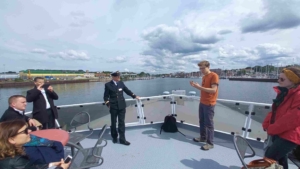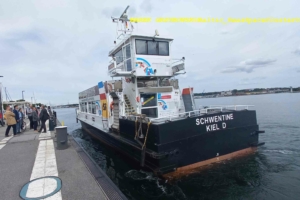Public water transport as an alternative to road traffic
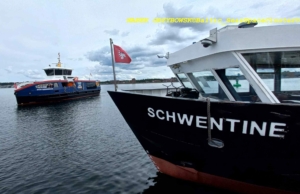
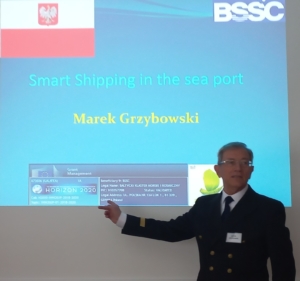 By Marek Grzybowski
By Marek Grzybowski
Dreams of low-emission ships and avoiding traffic jams could come true in coastal and riverside cities. Many countries are working on public water transport. In Poland, we still have to wait for such innovative solutions.
In mid-February 2022, the white fleet of Kiel, Gdynia’s partner city, was enriched with another electric unit. German operator Schlepp- und Fährgesellschaft Kiel (SFK Kiel) has taken over its second fully electric ferry, MS Wellingdorf. The ship began regular cruises in early September 2022.
She is a small ship for carrying passengers around Kiel waters. The ferry was built by the Dutch Holland Shipyards Group Wellingdorf. The unit is 24.7 meters long and 7.2 meters wide. She is the sister ship of Düsternbrook, which was commissioned in 2021.
Construction costs amounted to almost EUR 3.2 million. The ship was subsidized by the German Federal Ministry of Transport and Digital Infrastructure (BMDV), which supported the city with approximately EUR 480,000. under the “Clean Air” program.
The ship is completely emission-free and entirely powered by batteries with an installed capacity of 1,092 kWh. In addition to the battery pack, the ship has 20 solar panels on its roof to provide additional power.
The third electric ferry SFK MS Dietrichsdorf arrived in Kiel from Rotterdam on February 29, 2024 and sails on the Kieler Hörn River. The electric ferries fleet of the Kiel carrier will be expanded in 2024 by another passenger ferry. The new ferry is a completely electric ferry. She joined the two electric ferries in operation, Düsternbrook and Wellingdorf.
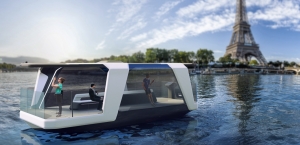
3D printed ferry on the Seine
During the Olympic Games in Paris in 2024, an autonomous electric ferry will sail on the Seine. Its hull will be 3D printed – announced Holland Shipyards Group and Sequana Développement and Roboat. These are the companies that won the tender announced by the French inland waterways authority Voies Navigables de France.
The winning consortium’s ferry will be 3D printed using recycled materials. It will be the largest autonomous ferry ever produced. The 9 by 3.9 m unit will carry passengers. In addition to moving autonomously on the river, the ship will moor automatically. The battery will also be charged automatically when the unit is moored.
– The 3D printing method of building opens a new, exciting chapter in the shipbuilding industry – said Leendert Hoogendoorn, director of Holland Shipyards Group, after announcing the order of the unit. The ferry will sail on the Seine in the summer of 2024. It will sail close to the most important sporting events.
Roboat designers have already conducted the first successful tests of the operation of autonomous ships sailing in metropolitan areas. The five-year Roboat program focused on developing and testing electric autonomous boats on urban waterways. – Autonomous ferries will create new connections on existing waterways in cities around the world – announces Ynse Deinema, CEO of Roboat.
The project’s creators argue that “the 777 km long Seine in Paris offers an ideal location for further implementation of autonomous electric boats in urban areas.” Earlier this year, the City of Paris and RiverCat France also announced that an autonomous electric passenger river transport service will be launched on the Seine in April 2024.
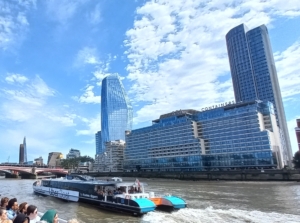
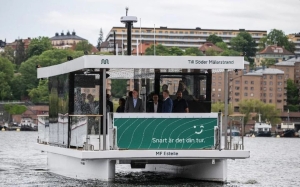
On the Thames ferries from Gdansk and East Cowes (Isle of Wight)
Electric car and passenger ferries manufactured in Poland sail between the banks of the Thames. Uber has already launched the first electric ship on the Thames and will operate others. We wrote about it In GospodarkaMorska.pl.
Norwegians are working intensively on zero-emission units. “When we present our concept to major city authorities around the world, the response is almost always ‘why didn’t we think of this before?'” says Erik Dyrkoren.
He is the CEO of Zeabuz, a Norwegian company developing zero-emission autonomous ferries for public transport in cities. He believes there is an obvious, if untapped, solution to many urban transportation problems. We wrote more about the Zeabuz project here [https://www.gospodarkamorska.pl/zeabuz-autonomym-minibusem-po-wodzie-a-moze-made-in-poland-59877]
“Transporting people by road – especially by car – is very space inefficient. Almost every city in the world struggles with traffic jams. This is not a problem that can be solved by building bigger roads. Metro and tram infrastructure is expensive to build. But while roads are packed to capacity, rivers and waterways are largely underutilized for transportation purposes.”
This is what Zeabuz and many other innovative Norwegian companies are currently changing. Their vision: a flotilla of electric, fully autonomous ferries transporting people on many of the world’s urban waterways. Rehearsals are already underway.
Norwegians emphasize that emission-free water public transport also reduces transport costs and saves transport time because it avoids traveling through crowded streets. Norwegian company Hydrolift Smart-City Ferries (Hyke for short) has developed an all-electric passenger ferry with space for 50 people that weighs just ten tons and can be produced in series.
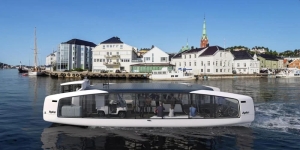
From Norway to the Olympic Games
The 15 m long and 5.7 m wide Hyke Shuttle 0001 has an output power of 60 kW to 150 kW, depending on the version. The ship is equipped with batteries with a capacity of 95 kWh to 285 kWh. The electric ferry is equipped with solar panels on the roof and can be automatically charged wirelessly. Hyke provides cruising speeds of up to 15 knots (28 km/h). At an economic speed of six knots, energy consumption has been calculated to be between 10 and 12 kWh per hour.
Paris has already ordered four units. Electric ferries from a Norwegian manufacturer will be used to transport passengers during the Olympic Games. Hyke expects to be able to initially produce around 15-20 ships per year. But it is ambitiously assumed that in the future it may be up to 100 units per year.
Hyke said it is also developing its own autonomous navigation technology that all ships will be equipped with. In the future, e-ferries will also be able to sail without a captain.
Norway has been extremely consistent in electrifying its ferry connections. Last year it was announced that the longest ferry route in Norway is to be electrified by 2025. Norway has been replacing ferries with electric ones for several years. The water transport replacement strategy has been adopted in virtually all major European agglomerations.
Poland is still not actively taking advantage of widespread decarbonization in ferry transport. Tricity, Szczecin and Świnoujście still rely on bus, trolleybus or tram transport. The authorities of cities located on the Bay of Gdańsk, the Szczecin Lagoon, the Vistula Lagoon and Polish rivers have not yet noticed the potential in inland transport.
